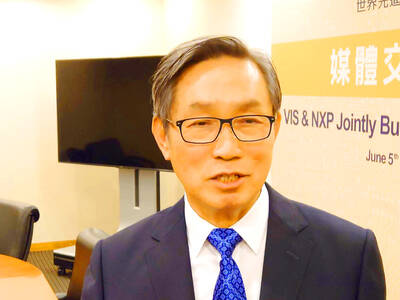Gold prices yesterday drove higher to a fresh record above US$2,350 an ounce as investors shifted focus to the release of a key US inflation reading tomorrow, while geopolitical risks also added to its appeal.
Spot gold was 0.2 percent higher at US$2,335.38 an ounce as of 1:41pm in Singapore, after earlier touching a record US$2,353.95.
The precious metal remains supported well above US$2,300, after notching a series of fresh all-time highs in the past few weeks.

Photo: Bloomberg
Yet, the move has left some onlookers puzzled amid a lack of any obvious trigger for the sudden rally which began in mid-February — especially as traders have unwound bets for steep rate cuts by the US Federal Reserve during that period. Higher rates are typically negative for gold, which does not pay interest.
Gold is up more than 18 percent since then, with at least some of the gains fueled by optimism that the Fed was getting closer to cutting rates.
Central bank demand has also been a factor, with the People’s Bank of China (PBOC) reporting an addition for a 17th straight month last month.
Bullion held by the PBOC rose 0.2 percent to 72.74 million troy ounces last month, according to official data released on Sunday. It was the smallest increase in the run of monthly purchases that began in November 2022.
Global central banks, led by China and India, continued adding to their gold reserves in February, marking a ninth straight month of growth, according to the World Gold Council.
Elsewhere, bullion has benefitted from increased haven demand amid persistent tensions in the Middle East.
Israel on Sunday said the country is removing some troops from southern Gaza after Prime Minister Benjamin Netanyahu said victory was within reach.
Meanwhile, Iran is preparing a response to a suspected Israeli attack on its consulate in Syria, while Hezbollah warned that it is ready for war.

TAKING STOCK: A Taiwanese cookware firm in Vietnam urged customers to assess inventory or place orders early so shipments can reach the US while tariffs are paused Taiwanese businesses in Vietnam are exploring alternatives after the White House imposed a 46 percent import duty on Vietnamese goods, following US President Donald Trump’s announcement of “reciprocal” tariffs on the US’ trading partners. Lo Shih-liang (羅世良), chairman of Brico Industry Co (裕茂工業), a Taiwanese company that manufactures cast iron cookware and stove components in Vietnam, said that more than 40 percent of his business was tied to the US market, describing the constant US policy shifts as an emotional roller coaster. “I work during the day and stay up all night watching the news. I’ve been following US news until 3am

Six years ago, LVMH’s billionaire CEO Bernard Arnault and US President Donald Trump cut the blue ribbon on a factory in rural Texas that would make designer handbags for Louis Vuitton, one of the world’s best-known luxury brands. However, since the high-profile opening, the factory has faced a host of problems limiting production, 11 former Louis Vuitton employees said. The site has consistently ranked among the worst-performing for Louis Vuitton globally, “significantly” underperforming other facilities, said three former Louis Vuitton workers and a senior industry source, who cited internal rankings shared with staff. The plant’s problems — which have not

UNCERTAINTY: Innolux activated a stringent supply chain management mechanism, as it did during the COVID-19 pandemic, to ensure optimal inventory levels for customers Flat-panel display makers AUO Corp (友達) and Innolux Corp (群創) yesterday said that about 12 to 20 percent of their display business is at risk of potential US tariffs and that they would relocate production or shipment destinations to mitigate the levies’ effects. US tariffs would have a direct impact of US$200 million on AUO’s revenue, company chairman Paul Peng (彭雙浪) told reporters on the sidelines of the Touch Taiwan trade show in Taipei yesterday. That would make up about 12 percent of the company’s overall revenue. To cope with the tariff uncertainty, AUO plans to allocate its production to manufacturing facilities in

TARIFF CONCERNS: The chipmaker cited global uncertainty from US tariffs and a weakening economic outlook, but said its Singapore expansion remains on track Vanguard International Semiconductor Corp (世界先進), a foundry service provider specializing in producing power management and display driver chips, yesterday withdrew its full-year revenue projection of moderate growth for this year, as escalating US tariff tensions raised uncertainty and concern about a potential economic recession. The Hsinchu-based chipmaker in February said revenues this year would grow mildly from last year based on improving supply chain inventory levels and market demand. At the time, it also anticipated gradual quarter revenue growth. However, the US’ sweeping tariff policy has upended the industry’s supply chains and weakened economic prospects for the world economy, it said. “Now